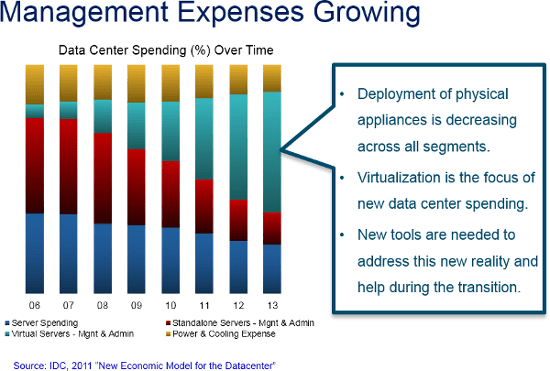
Back in the early and mid-2000’s the race was on to implement an out-of-band infrastructure (OOBI) to provide access and control to all your IT assets in the data center via a separate management network. Isolating device management to a separate management network was, and still is a great practice. Having the ability to remotely connect to a device in the data center via an isolated network, allows users to perform various tasks such as Reboot, Power off, Power on, run a specific script, provision, test, etc. of specific devices, without impacting the production network processing. Another benefit (among many) is being able to connect to a failed production network device and bring it back in service via remote access and management. Reduces recovery time. Minutes can mean millions when it comes to a production IT outage. The faster you can respond, the less it costs.
Currently, and some 10 years ago, implementing an OOBI required various hardware appliances to be installed in your network to provide access to the device. Serial Console Servers, KVM/IP Switches, Intelligent and Controllable Rack PDU’s, etc… which you need to purchase and install in your data center. 1000’s of dollars were, and still are being spent on the purchase and implementation of these appliances. Why? Because that’s how you do it. Buy more management appliances and add them to your existing infrastructure as you grow. In an attempt to keep up with new technologies like Service Processors (IPMI, ILO, Drac, CIMC, etc) and the explosion of Virtualization, the manufactures have addressed this by creating another appliance for you to buy, add to your rack and network, just to facilitate the access and control to the Service processors and Virtual Machines. These solutions also require periodic updates or upgrades to the vendor specific management software, which was developed (for what was available at the time) over 10 years ago, and based on the use of appliances (sell you more hardware). Not what’s available now.

Today, Virtualization and Service processors are aggressively being adopted in data centers. This greatly reduces the need for expensive, rack cluttering, and heat generating KVM/IP Switches, and perhaps, in some cases, reduced the need for expensive rack PDU’s. Quite a cost savings. But still not enough. Most all OOBI management solutions require additional hardware appliances in order to consolidate and provide access to the Service Processor or Virtual Machine infrastructure. Again, this method of implementing an OOBI came about 10 years ago and required hardware components (KVM/IP, Serial Console, Intelligent Rack PDU’s, Service Processor, and virtual Machine consolidators) in order for it work. And let’s not forget the vendor specific management tools that are useless without the presence of vendor specific appliances and don’t integrate with equivalent competitor products. For example, Console Servers from different vendors. As a result, you, the users are locked in to a specific vendor technology and method of OOBI management. To frame this differently, suppose your company purchases a company which standardized on an OOBI from vendor A. You’re standardized on vendor B. How do you handle this? Maintain both solutions until you can replace one with the other. Buy more hardware from your preferred OOBI manufacturer to replace the hardware from the other manufacturer. Either way, it’s costly and locking you into a specific vendor OOBI technology and method.
So, what can you do? Continue to expand your OOBI infrastructure from a specific vendor with outdated methods and solutions, OR, you could implement a vendor neutral OOBI software-only management solution that provides the same, if not better, secure access and control to devices from both Vendor A and B without having to add additional hardware appliances. Now you can have OOB connectivity and management of your Physical and Virtual infrastructures as it grows, and expands via whatever vendor/s products you decide to use. In fact, you could use a combination of Vendor A, B, C, and D’s OOB appliances to rebuild a best of breed OOBI. Let Freedom Ring. No more OOBI vendor lock-in.
From the team that gave us the Linux Break Safe Console Server, Managed Rack PDU’s, and put IPMI in Service processors, comes the world’s first Software-Only, Vendor Neutral Access and Control solution for the management of both Physical and Virtual (VMware and Kernel Virtualization) IT device Infrastructures, regardless of manufacturer. “NodeGrid Manager” is the first software-only solution for Access and Control that doesn’t require any additional hardware components to provide access and control to your existing OOBI, regardless of manufacturer. NodeGrid Manager’s agnostic approach to device management allows you to take advantage of your existing hardware OOBI without regard for manufacturer, or the addition of expensive KVM/IP, or service processor and virtual machine consolidator hardware appliances. As a byproduct, NodeGrid Manager frees you from vendor lock-in. NodeGrid provides the same user experience regardless of device and manufacturer via a common UI and standardized feature and command stack across the entire infrastructure. User experience is the same for Server, Storage, Network, Power, and Virtual Machine (VMware and Kernel Virtualization) infrastructure regardless of manufacturer
If it hasn’t already happened, there will come a time when your existing OOBI starts letting you down. When that happens, turn to ZPE Systems NodeGrid Manager for relief. NodeGrid Manager Delivers a true vendor-neutral experience in OOBI management. Oh, and did we mention you don’t have to add expensive vendor specific proprietary appliances to manage your physical and virtual IT infrastructure

Free your OOBI now from vendor lock-in. Stay ahead of technology changes and growth with NodeGrid Manager. The world’s first, Software-Only, Vendor-Neutral Access and Control Solution for both Physical and Virtual IT Infrastructures, that simply and easily works, and scales to meet your needs.
See for yourself.
The fastest way to learn more – Email us at sales@zpesystems.com (or call +1 510 298 3022) to schedule a chat or request a demo.
